How To Move Heavy Objects
Almost everyone, at one time or another, has wondered how to move heavy objects. This could be when moving into a new place, or moving out of one. Or it could just be a question that comes up when re-arranging heavy objects around the house. The fact is that, when it comes to moving heavy objects, our muscles are frequently inadequate. Fortunately, by applying a bit of physics, you can go a long way towards saving yourself lots of time and effort, and your back! In fact, all the techniques I discuss here allow you to move, or lift, heavy objects by yourself, in many cases. The main principles of physics that are applied when moving heavy objects with relative ease are: Leverage and friction reduction.The Dolly
Let's start with a simple tool you can get which most people are familiar with – the dolly (also known as a hand truck). The dolly is all about leverage, from the easy lifting of the object, to the transporting of the object from one place to another. The figure below illustrates a dolly being used to pick up a heavy object. You just slide the bottom of the dolly underneath the object, and then tilt the dolly back to lift the object off the ground.
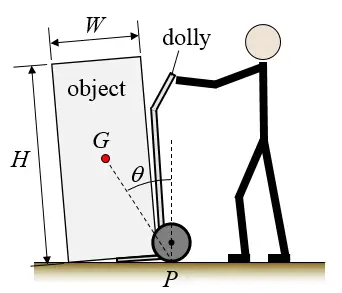
In the figure, H represents the height of the object, and W represents the width of the object. The angle θ represents the angle between the vertical, and the line passing through the contact point P (between wheel and ground) and the center of mass of the object G. The initial lifting of the object is typically easier for objects that are significantly taller than they are wide. This means that H is significantly greater than W, which means that θ is smaller. A shorter H would result in a larger θ just by the geometry of the situation. A larger θ results in a larger resisting torque about point P than if θ is small. A larger resisting torque (caused by the object weight) means that you have to tilt the dolly back with greater force in order to lift the object off the ground. From physics class, remember that the weight of an object effectively acts through its center of mass.
Once the object is lifted off the ground, you then transport it to the desired location simply by rolling the dolly along.
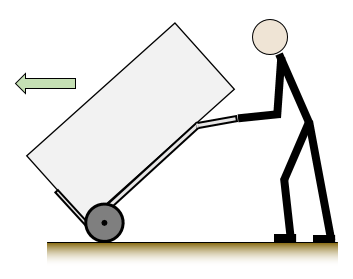
At this point, most of the weight of the object is supported by the wheels of the dolly, and the remainder of the weight is supported by you. You just have to hold the orientation of the dolly fixed, while at the same time pushing (or pulling) with a certain amount of force in order to move the dolly along. This push (or pull) force usually isn't much because of the presence of the wheels. This force is that required to overcome rolling resistance, which is necessary in order to move the dolly along. The great usefulness of the dolly means that you can often use it by yourself to move heavy objects around. Although it might be better (and safer) to have someone helping you out, in the initial and final stages, where the object is being loaded onto the dolly, and then unloaded from the dolly.
Reducing Floor or Ground Friction
Sometimes you don't need to actually lift an object in order to move it. You can just move it along the floor to its desired location. There are two simple methods to do this. For the first method, you can use a strong blanket (or towel) placed underneath the object, which reduces the friction force between the floor and the object, and also prevents scratching the floor. Then you just pull the object along the floor to where you want it, which is made easier due to the low friction between floor and object. This is a good strategy to use for indoors when you have a non-carpeted smooth floor. The figure below illustrates this method.
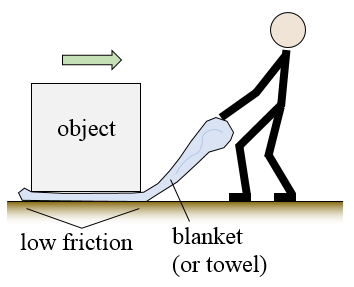
For the second method, you place rollers underneath the object and then push it along. You have to continuously add a roller underneath the moving front end of the object to keep it moving. The figure below illustrates this method.
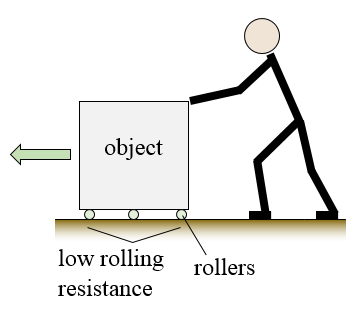
Essentially, you are placing the object on wheels, and this method is ideal when you don't have a dolly or a dolly wouldn't work, perhaps because the object has a short height and large width which would make it difficult to load onto the dolly. The only force you have to apply here is that required to overcome rolling resistance, which is low. This method works well for carpeted floors and for outdoors. The rollers could do damage on hard floors due to the high pressure at the points of contact between rollers and floor, so don't use them there. In terms of what to use as rollers, you can use broom handles, PVC pipe, dowels, etc.
The above method is similar to using a cart to move the object, except that it's more of a "homemade" method. If you happen to have a cart you can use that instead of rollers. A cart used for moving objects is simply a platform with three or four wheels underneath. It works well outdoors, and also indoors provided you're careful not to damage the floor due to the high-pressure contact between wheels and floor.
Generating Large Pulling Force
The last method I want to discuss is definitely for outdoors. This is a method I once used when I had to pull a heavy steel beam out of a shed. Because of its great weight and long length, and awkward location, my only option to move it was to pull it out. Unfortunately, my physical strength was limited. Fortunately, I had leverage on my side. What I did was get a long steel rod, and pushed it into the ground maybe 8 inches deep, and then connected a rope from the beam to the rod, maybe a foot off the ground. I then pulled on the top of the rod, and used the great amount of leverage to exert the high force needed to pull the beam out of the shed. I did this bit by bit, constantly inserting the rod into the ground at new locations, and yanking the beam out a bit each time. The figure below illustrates the basic set up. Note that I use a general object in the illustration rather than a beam.
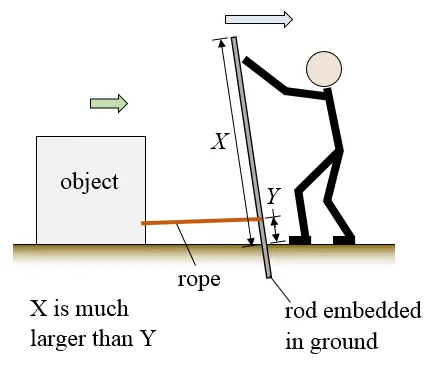
Note that the rod is inserted at an angle to the ground. This allows for maximum pulling distance of the top of the rod, which results in maximum pulling distance for the beam. The distance from the top of the rod to the ground (which serves as a pivot point, effectively) is represented by X, and the distance from the rope location to the ground is represented by Y. In order for this method to work, X has to be much greater than Y. By the law of the lever, this results in the pulling force on the rope being much larger than my pulling force on the top of the rod.
Moving Objects Up And Down Stairs
For moving heavy objects up and down stairs, I recommend you don't do it by yourself. It's at minimum a two person job! It helps to be creative when moving heavy objects up and down stairs. One way is to put a wooden plank (or two) on the stairs, with a blanket on top to prevent scratching the object, and then slide the object up (or down) the stairs. By doing this you have transformed a set of stairs into an inclined plane. An inclined plane is a well-known concept in physics that makes the raising or lowering of an object easier. The figure below illustrates this. Just make sure the plank stays stationary when sliding the object.
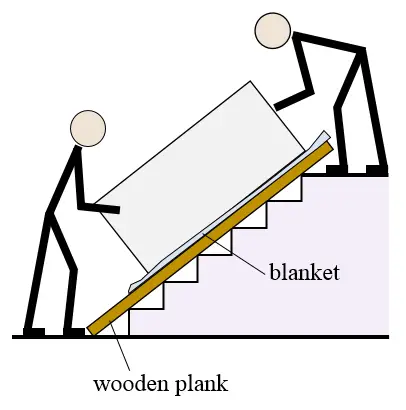
Another way to move a heavy object up or down stairs is to use a dolly, as shown in the figure below.
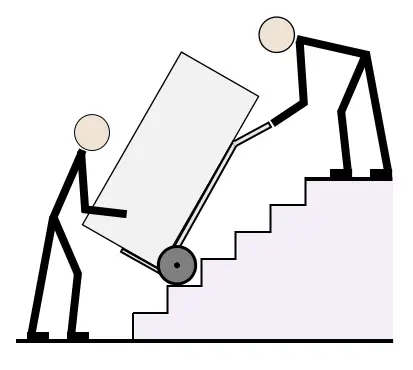
When it comes to using a dolly to move objects up or down stairs there is also a specialized stair-climbing variety that you can use. It has three wheels on each side, which pivot along a main axle, as they move along the stairs. Basically, the way it works is that it allows the center of mass of the dolly (plus load) to roughly travel along the inclined direction of the stairs, which makes it easier to pull the dolly up the stairs. When you use a regular dolly on stairs, you have to lift the full dolly weight (plus load) up each individual step to get it up to the next step. However, with the stair-climbing dolly, the force necessary to pull it up a set of stairs is similar to the force it would take to pull it up a ramp having the same inclination as the stairs. This means that the force is less than with a regular dolly, and this is because of the geometry of the three-wheel configuration. The video below shows an example of a stair-climbing dolly.
The Forearm Forklift
This is a harness you can wear which makes manual lifting much easier. It helps you maintain upward posture when lifting an object, which helps prevent injury. This works best when there is another person on the opposite end of the object, also lifting with this harness. The video below shows this harness in action.
Last but not least, you want to make the objects as light as possible before moving them. This can be done by either removing items contained inside or disassembling components, if possible. For example, you can remove drawers from dressers, and take out all the things inside. And some objects can be easily disassembled, such as certain types of beds and desks.
That completes the summary of the different methods you can use to move heavy objects. I didn't go into too much detail on the physics, other than to touch on some basic concepts. Applying this knowledge can really help you move heavy objects, even by yourself in many cases.
Return to Miscellaneous Physics page
Return to Real World Physics Problems home page
Free Newsletter
Subscribe to my free newsletter below. In it I explore physics ideas that seem like science fiction but could become reality in the distant future. I develop these ideas with the help of AI. I will send it out a few times a month.